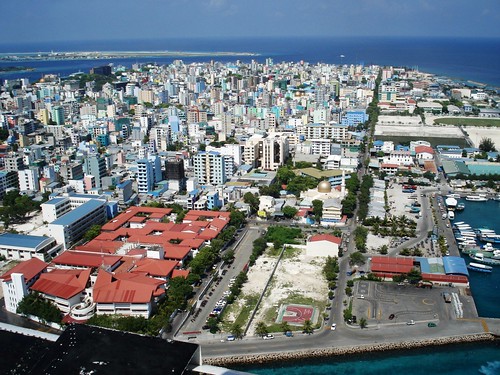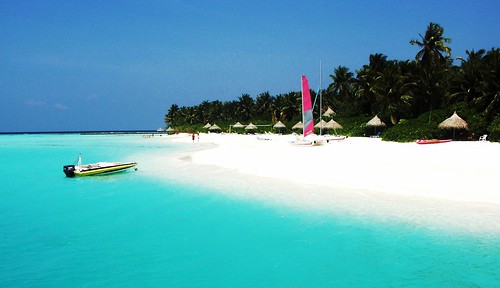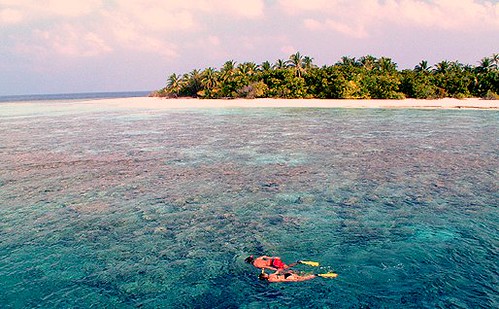The Maldives (en-us-Maldives.ogg /ˈmɒldaɪvz/ (help·info) or /ˈmɒldiːvz/), (Dhivehi: ދިވެހިރާއްޖެ Dhivehi Raa’j) or Maldive Islands, officially the Republic of Maldives, is an island country consisting of a group of atolls stretching south of India's Lakshadweep islands between Minicoy Island and the Chagos Archipelago, and about seven hundred kilometres (435 mi) south-west of Sri Lanka in the Laccadive Sea of Indian Ocean. The twenty-six atolls of Maldives encompass a territory featuring 1,192 islets, of which two hundred islands are inhabited.
The original inhabitants were Buddhist, probably since Ashoka's period,[citation needed] in the 3rd century BC. Islam was introduced in 1153. The Maldives then came under the influence of the Portuguese (1558) and the Dutch (1654) seaborne empires. In 1887 it became a British protectorate. In 1965, the Maldives obtained independence from Britain (originally under the name "Maldive Islands"), and in 1968 the Sultanate was replaced by a Republic.
The Maldives is the smallest Asian country in terms of both population and area; it is the smallest predominantly Muslim nation in the world. With an average ground level of 1.5 metres (4 ft 11 in) above sea level, it is also the country with the lowest highest point in the world, at 2.3 metres (7 ft 7 in).
capital city of Maldives known as the smallest city in the world more than 90,000 peoples, 500 ft up in the air...
A tsunami in the Indian Ocean caused by the 2004 Indian Ocean earthquake caused serious damage to the socioeconomic infrastructure which left many people homeless, and irreversible damage to the environment. After the disaster, cartographers are planning to redraw the maps of the islands due to alterations caused by the tsunami.
On 22 April 2008, then Maldives President Maumoon Abdul Gayoom pleaded for a cut in global greenhouse gas emissions, warning that rising sea levels could submerge the island nation of Maldives. In 2009, subsequent president Mohamed Nasheed pledged to make the Maldives carbon-neutral within a decade by moving to solar and wind power.
The reef is composed of coral debris and living coral. This acts as a natural barrier against the sea, forming lagoons. Other islands, set at a distance and parallel to the reef, have their own protective fringe of reef. An opening in the surrounding coral barrier allows access to the calmer lagoon waters.
Blue Lagoon View. Maldives Nature.
Snorkelling in the Maldives. Coral Reefs, Opportunity to observe Underwater life in a Natural setting.
The Maldives was largely terra incognita for tourists until the early 1970s. Strewn across the equator in the Indian Ocean, the Maldives archipelago possesses an exceptionally unique geography as a small island country. Nature has fragmented the archipelago into 1,190 tiny islands that occupy a mere one per cent of its 90,000 sq km territory.
Only 185 islands are home to its 300,000 population, while the other islands are used entirely for economic purposes of which tourism and agriculture are the most dominant.Tourism accounts for 28% of GDP and more than 60% of the Maldives' foreign exchange receipts. Over 90% of government tax revenue comes from import duties and tourism-related taxes.[citation needed].
The development of tourism has fostered the overall growth of the country's economy. It has created direct and indirect employment and income generation opportunities in other related industries. The first tourist resorts were opened in 1972 with Bandos island resort and Kurumba Village.
According to the Ministry of Tourism website,the emergence of tourism in 1972 transformed the economy of the Maldives, moving rapidly from the dependence on the fisheries sector to the tourism sector. Just in three and a half decades, the industry has become the main source of income and livelihood of the people of the Maldives.
Tourism is also the country’s biggest foreign currency earner and the single largest contributor to the GDP. Today, there are 89 resorts in the Maldives with a bed capacity of over 17,000, providing world class facilities for tourists whose annual arrival figure exceeds 600,000.
The report published in Dhivehi language, mentions that the number of resorts has increased from 2 in 1972, to 92 by the end of 2007. Up to 2007, a total of 8,382,928 tourists have visited Maldives.
Underwater restaurant in Maldives (Conrad Maldives Rangali Island), the first totally underwater restaurant in the world. You have to book a table two weeks before you go there to make sure you get one, there are only 7 tables and it cost around 700$ US for two but it was worth it ^_^








0 comments:
Post a Comment